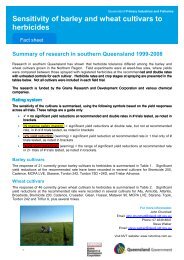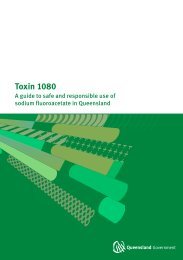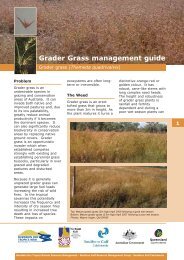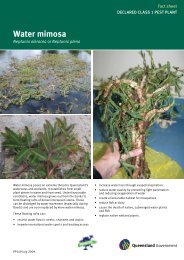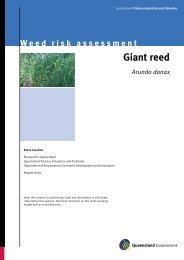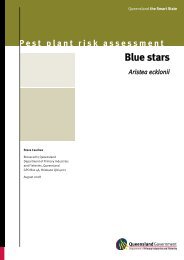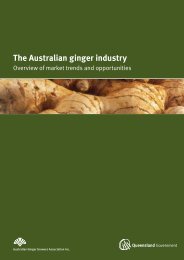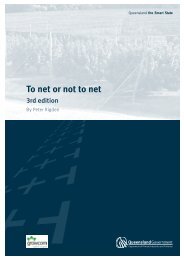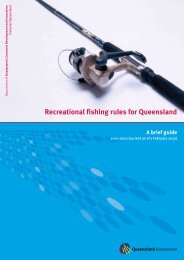Insect Control in Stored Grain - Department of Primary Industries
Insect Control in Stored Grain - Department of Primary Industries
Insect Control in Stored Grain - Department of Primary Industries
You also want an ePaper? Increase the reach of your titles
YUMPU automatically turns print PDFs into web optimized ePapers that Google loves.
Table 8: Phosph<strong>in</strong>e tablets - Application rates for phosph<strong>in</strong>e tablets <strong>in</strong> storages <strong>of</strong><br />
various sizes.<br />
Storage capacity<br />
Tonnes wheat Bushels Cubic metres<br />
Number <strong>of</strong> tablets required<br />
20 730 27 40<br />
50 1830 65 100<br />
100 3660 130 200<br />
300 11000 400 600<br />
Notes on Table 8:<br />
A storage needs the same amount <strong>of</strong> fumigant regardless <strong>of</strong> whether it is full, partly full, or empty.<br />
For example, a storage with enough space to hold 100 tonnes <strong>of</strong> wheat always needs 200 tablets<br />
no matter how much gra<strong>in</strong> it conta<strong>in</strong>s.<br />
Other solid formulations release various quantities <strong>of</strong> phosph<strong>in</strong>e rang<strong>in</strong>g from 0.2 grams to one<br />
kilogram. Follow label recommendations for those formulations.<br />
M<strong>in</strong>imum fumigation times follow<strong>in</strong>g application <strong>of</strong> phosph<strong>in</strong>e are –<br />
• 7 days at gra<strong>in</strong> temperatures above 25 o C;<br />
• 10 days at 15 to 25 o C.<br />
Gra<strong>in</strong> below 15 o C should not be fumigated with phosph<strong>in</strong>e - <strong>in</strong>sects are very hard to kill at low temperatures.<br />
Fumigant takes longer to distribute <strong>in</strong> storages with more than a few hundred tonnes capacity, unless forced<br />
circulation is used. Longer exposure periods are required <strong>in</strong> larger storages. See product label for details.<br />
Air<strong>in</strong>g (ventilat<strong>in</strong>g) and withhold<strong>in</strong>g periods for phosph<strong>in</strong>e<br />
Fumigated gra<strong>in</strong> must be aired before handl<strong>in</strong>g to remove toxic gas and to m<strong>in</strong>imise phosph<strong>in</strong>e gas<br />
residues. Flow-through ventilation aided by a fan usually allows completion <strong>of</strong> air<strong>in</strong>g <strong>in</strong> 24 hours. Without a<br />
fan this could take 5 days. A withhold<strong>in</strong>g period <strong>of</strong> two days after the air<strong>in</strong>g period applies before the gra<strong>in</strong> is<br />
used for human food or stockfeed. Gra<strong>in</strong> can be legally transported dur<strong>in</strong>g this period.<br />
Total fumigation time for phosph<strong>in</strong>e<br />
The m<strong>in</strong>imum period allowable between application <strong>of</strong> phosph<strong>in</strong>e and use <strong>of</strong> the treated gra<strong>in</strong> is 7<br />
days exposure + 1 day air<strong>in</strong>g with fans + 2 days withhold<strong>in</strong>g period, or 10 days total. If gra<strong>in</strong> temperature is<br />
less than 25 o C, so that a longer exposure period is needed, or air<strong>in</strong>g is done without fans, the m<strong>in</strong>imum<br />
allowable period between application and use <strong>of</strong> the gra<strong>in</strong> can be as long as 17 days. In storages larger<br />
than 300 tonnes, an exposure period <strong>of</strong> 20 days is required, so total fumigation time is up to 27 days. Always<br />
refer to the label.<br />
Safety with phosph<strong>in</strong>e<br />
Phosph<strong>in</strong>e is very toxic to people and farm animals. Health workers specify an air concentration <strong>of</strong> 0.3 ppm<br />
as acceptable <strong>in</strong> work areas. Gas detector tubes are one method <strong>of</strong> monitor<strong>in</strong>g workplace concentrations.<br />
Two Australian firms sell<strong>in</strong>g phosph<strong>in</strong>e detectors can be contacted at the Canary Company at<br />
www.thecanaryco.com and Airmet at www.airmet.com.au. There may be other companies <strong>in</strong> this field also.<br />
Note that most gas detection / monitor<strong>in</strong>g equipment requires regular check<strong>in</strong>g and calibration to verify<br />
accuracy and reliability. So potential buyers should be aware <strong>of</strong> the cost <strong>of</strong> this check<strong>in</strong>g and service<br />
availability.<br />
13





